

Jamestown Artifacts
All historic artifacts provided by Jamestown Rediscovery, except the Jamestown Model Fort, which was provided by the Colonial National Historical Park, National Park Service.


All historic artifacts provided by Jamestown Rediscovery, except the Jamestown Model Fort, which was provided by the Colonial National Historical Park, National Park Service.
| Chinese Porcelain Wine Cup | |
|
Jamestown Rediscovery's archaeologists excavated this nearly complete Chinese porcelain wine cup from a ca. 1610 context within the fort. This cup probably was part a shipment of goods that the Dutch purchased in the East and then sold in England. A gentleman at Jamestown either purchased the wine cup or received it as a gift. He might have drank aqua vitae (an alcoholic beverage that was part of each colonist's supplies) from the cup or used it as an indication of his status as a gentleman. |
 |
| William Strachey's Ring |
A colonist named William Strachey wore this ring during the year that he was at Jamestown. Strachey was one of the colonists who left for Virginia on the Sea Venture in 1609. This ship encountered storms on the voyage across the Atlantic Ocean and was wrecked on Bermuda. Strachey and the Sea Venture's other passengers did not arrive in the colony until 1610. He left Virginia in 1611. Strachey wrote an account of his voyage to Virginia—The Historie of Travell into Virginia Britania (1612). Some scholars believe that William Shakespeare based his play, The Tempest, on Strachey's account. |
 |
| Silver Ear Picker |
The silver ear picker is in the shape of a "sea rhinoceros" or dolphin. This cosmetic implement has an ear scoop on one end and a tooth/nail cleaner on the other end. The owner of this ornate ear picker might have used the loop to hang it from a girdle or a chain around his neck as an indication of his status. It is possible that the owner was a gentleman who spent several years sailing across the Atlantic Ocean before he settled at James Fort. Surgeons also used ear pickers (made of either bone or a cheaper metal) in the sixteenth and seventeenth centuries. |
 |
| Bottom Collar Section of a Glass Alembic |
An alembic is one of the two main sections of a distilling unit used by a metallurgist to produce nitric acid (which he used to separate gold from silver). A metallurgist poured sulfuric acid in the cucurbit, the bottom portion of the distilling unit, and placed it over a flame. The vapor condensed in the alembic and then the condensate dripped out of the alembic's spout into a bottle or flask. Archaeologists found this portion of a glass alembic in the cellar of a building that was constructed before 1610. |
 |
| Goffering Iron |
It is likely that a gentleman at James Fort used a goffering iron to crimp or frill a large neck ruff that was fashionable for English men between ca. 1580 and 1610. First, he used white starch to add stiffness to the ruff. Next, a gentleman heated the goffering iron by putting a smaller, hot iron inside the tube. Finally, the man shaped his ruff with the hot goffering iron. |
 |
| Buckler |
A buckler was a small leather shield that soldiers used from the thirteenth century to the late sixteenth century. A soldier held a buckler in his left hand and a sword in his right. Most bucklers were round and they measured between eleven and fourteen inches in diameter. The leather was reinforced with metal and had an iron boss with a projecting spike in the center. |
 |
| Rapier |
In the sixteenth century, Italian fencing masters began to teach their students to fence with rapiers. A fencer held a rapier with its long, sharp blade in one hand and a dagger in the other hand to block thrusts. Soldiers stopped using bucklers in the last quarter of the sixteenth century because these small shields did not provide much protection against a man with a rapier. |
 |
| Red-glazed English Border Ware Chamber Pot |
A potter produced this chamber pot in a pottery on the border between Hampshire and Surrey counties in England. The handle is missing and the red glaze is on the interior. Members of the English upper class might have had silver chamber pots in the early seventeenth century. It is likely that a colonist at Jamestown decided to bring this Border ware chamber pot to Virginia. Chamber pots were not common in the first half of the seventeenth century and they were not on the list of supplies that the Virginia Company of London gave to the settlers. |
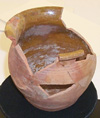 |
| Potomac Creek Pot |
These sherds are from a pot made by the Patawomeke Indians who lived at Patawomeke, their village on the Potomac Creek. The decorations on the rim were made with a cord-wrapped dowel. An analysis of the interior of the pot indicates that someone cooked a corn and deer meat stew in the vessel. It is possible that the pot was a trade item between the Patawomekes and the Powhatan Indians or between the Patawomekes and the settlers at Jamestown. It is likely that a colonist threw out the pot after he ate the food. The pot, like most Indian pots, had a rounded bottom and it would not stand on a flat surface. |
 |
| Dutch Delftware Pharmaceutical Jar |
One of the first doctors at Jamestown probably used this pharmaceutical jar to store medicine, plant material, a salve, or an ointment. These cylindrical jars were used for medicines in the middle ages and were mentioned in early recipe books for storing sweets and marmalades. It is likely that this jar was Dutch because of the early context in which archaeologists found it. Also, the Dutch favored the use of antimony to produce orange decorations. Many of the early pharmaceutical jars produced in England were blue and white. |
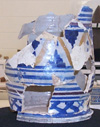 |
| Anglo or Dutch Pharmaceutical Jar |
This pharmaceutical jar was made in either England or Holland. It is difficult to determine its origin because English merchants shipped clay to the Netherlands. The decorations on the jar and the hastily-executed X pattern are similar to sherds that archaeologists have found in excavations of kilns in England. Sherds of pharmaceutical jars are the most common item found in the early sections of James Fort. |
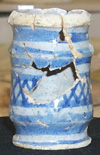 |
| Spanish Olive Jar |
In spite of its name, a Spanish olive jar might have contained wine, oil, water, pitch, turpentine, honey, vinegar, rice, beans, capers, chick peas, almonds, or lead bullets. It is likely that this jar held wine because it is the size and shape of wine containers. There is part of a stamp on the lip of the jar, a sign that this particular jar was to be re-used. The shape of the neck indicates that a cork sealed the jar. The Spanish developed olive jars in the late sixteenth century because they needed containers in which they could ship provisions to their settlements and colonies in the New World. Previously, the Spanish shipped food in barrels and casks made out of wood; however, they had used all of their seasoned oak to build vessels when the Spanish Armada made an unsuccessful attack against the English in 1588. Spanish potters produced this type of container quickly and at a small cost. These jars proved to be quite sturdy and withstood rough treatment during voyages to the New World. In addition, the rounded shape of the containers meant that they fit closely against the curved hull of a ship. The jars could be stacked near each other and on top of each other. A woven mat of esparto grass covered the jar and provided protection for the container and its contents. Wine was a beverage that the early residents of Jamestown wanted to have. The settlers found that the water near the James Fort was often contaminated and that beer spoiled quickly in the summer heat. However, the Virginia Company of London did not send wine to Jamestown on a regular basis because it was expensive. It is possible that Virginia-bound colonists traded with the Spanish or the Dutch for this Spanish olive jar and its contents in the West Indies. |
 |
| Green-glazed English Border Ware Drinking Jug |
This green-glazed drinking jug (also known as a green beer pot) was made in a pottery located along the border between Hampshire and Surrey counties in England. A potter made the jug from white firing clay in the early seventeenth century. An olive green glaze covers the upper half of the vessel. The drinking jug dates from the early seventeenth century. Archaeologists found the jug in the bulwark of James Fort. It is rare because it is a complete vessel. |
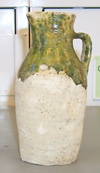
|
| Fragments of Crucibles Used to Make Glass at Jamestown |
These objects are fragments from a crucible made in the Hesse area of Germany. A potter made the crucible out of refractory clay that can expand and withstand very high heat without breaking. Beaker-shaped crucibles were used to make glass samples and pottery glazes. Sometimes the craftsman used two crucibles—one as a lid and the other as a container—when he heated the raw materials. He had to break the join between the two crucibles in order to get the liquid glass. It is possible that one of the three German glassmakers whom the Virginia Company of London brought to the colony broke open this crucible soon after his arrival on the Mary and Margaret in September 1608. The officials of the Virginia Company of London wanted the glassmakers—Adam, Francis, and Samuel—to make window glass that could be used in London. The Mary and Margaret carried a "trial" of glass that the German glassmakers produced when it returned to England in November of 1608. Adam, Francis, and Samuel had to prove that it was possible to make glass in Virginia before they would receive money to build a glass works. It is likely that the glassmakers made their "trial" inside the fort because the first reference to a glass house was not until the spring of 1609. In December 1608, John Smith sent the three German men to build a house for Powhatan because he did not have enough food to feed them. The glassmakers got food from the Indians and decided to assist the Powhatans in a possible attack against the colonists. Adam, Francis, and Samuel used the new glass house on Glass House Point as the mid-point when they smuggled arms out of James Fort. It does not appear that they produced much if any glass in this structure. Smith realized what the glass makers were doing, but welcomed them back to the fort. The Indians killed Francis in the winter of 1609. Adam and Samuel met the same fate in May 1610. The Virginia Company of London made a second attempt to produce glass at Jamestown in the 1620s when a group of Italian glassmakers arrived in the colony. This group of craftsmen planned to make drinking vessels. It is likely that they wanted to produce clear glasses instead of vessels that were green because of the large amount of iron oxide in the beach sand used as the source of silica. Another item that the Italians intended to manufacture was glass beads that the colonists would trade to the Indians. It is probable that the glass beads used in the Indian trade came from Venice, the center of glass production. The Spanish purchased beads that they exchanged with Indians in Venice. The Italian glassmakers did not have much luck in their attempts to produce glass at Jamestown. First, they either built or rebuilt a glass house. A hurricane blew down this structure. Next, one of the couples had a fight and the husband decided to use an iron rod to attack his wife. This glassmaker hit the furnace instead of his wife. Later, the furnace exploded because of a crack that it received when the glassmaker struck it with an iron rod. The 1622 Indian attack also limited efforts to make glass. Finally, the Italians informed George Sandys that the sand near Jamestown did not produce good glass. Sandys did not locate a source of better sand and the glass makers were sent back to Italy. |
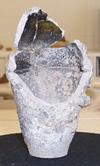
Image 1 
Image 2 |
| Copper Bead and Pendant |
The English settlers at James Fort studied the drawings of John White and the writings of Thomas Hariot before they sailed across the Atlantic Ocean. They learned that the Powhatan Indians valued copper as highly as the English valued gold. The early shipments to the colony included sheets of copper that the English purchased in central Europe. This was more economical to send sheets of copper to the colony than to trade whole copper pots or sections of pots to the Indians as the Dutch did. Some of the early settlers at Jamestown probably studied the copper beads and ornaments that the Powhatan Indians wore and produced similar items out of the copper sheets. The English colonists who produced copper beads and pendants did not put their own stamp or decorations on the objects. They kept them simple as they saw the Indian-made beads and jewelry were. The settlers at James Fort traded the copper objects to the local Indians for food. The copper beads and pendants were important trade items in the early years of the colony. There was a small source of copper in an area of southwestern Virginia that the Monacan Indians controlled. However, the Powhatans and the Monacans were at war in the early seventeenth century. The Monacans also prevented the Powhatans from participating in a trade network that extended from Virginia to the Midwest and to a source of copper in present-day Michigan. |
 |
| Tobacco Pipe Made by Local Indians and By Settler at Jamestown |
An Indian who lived near Jamestown made the top tobacco pipe. It is possible that it was a trade item or a symbol of friendship between an Indian and a colonist. A settler at James Fort, possibly Robert Cotton, manufactured the bottom tobacco pipe. The English learned the practice of smoking tobacco in clay pipes from the Indians. Smoking was popular in English by the late sixteenth century. |
 |
| Tobacco Pipe (Possibly Made in Holland) |
It is possible that a Dutch pipemaker manufactured this tobacco pipe. The bowl on the pipe was smaller than the bowls on pipes made by Powhatan Indians. It is likely that the small size of the bowl on the Dutch tobacco pipe (and also on pipes produced in early seventeenth-century England) reflected the high cost of tobacco before Virginians began to export tobacco to England. Before the1614, English and Europeans smoked Caribbean tobacco which had a sweet taste, but was difficult to grow. It is also possible that the Powhatan Indians made pipes with large tobacco bowls because several Indians smoked from the same pipe during a social gathering. The colonists' practice was for each man to have his own pipe. |
 |
| Irish Coins |
These coins are copper pennies minted in London between 1601 and 1602 for use in Ireland. Queen Elizabeth I preferred to keep silver coins, including pennies, in England. It is possible that the colonists brought these cooper pennies to Virginia because they wanted to have some money. Once in the colony, the settlers might have traded copper coins to the Powhatan Indians. |
 |
| Indian Ax |
This Indian ax was made from quartzite. |
 |
| Indian Projectile Points |
These projectile points (also called hafted bifaces) fit into the end of an arrow. They were made of dark chert. The Powhatans made triangular-shaped projectile points at the time of contact between the Indians and the English. Jamestown Rediscovery archaeologists have found seventy-nine projectile points in the fort. The fact that many of the projectile points are unbroken and made of non-local stones suggests that they were not on the arrows that the Powhatan Indians shot at the colonists during the Anglo-Indian conflicts. Instead, they might have been part of gift arrows that the Indians gave to the settlers. |
 |
| Early Seventeenth-Century English Border Ware Bowl |
A potter made this vessel in the Hampshire-Surrey County region of England. This bowl has a double basin and it appears that the outer basin has drain holes. At this point in time, the Jamestown Rediscovery archaeologists do not know how residents at the James Fort used this bowl. |
 |
| JR102C |
On September 5, 1996, JR102C (the scientific name) was found 100 yards from the southeast bulwark and within the archaeological footprint of James Fort. The skelton had a .60 caliber ball still in place, lodged just below the right knee. From an examination of the skeleton and forensic reconstruction of the face, experts have determined that JR102C was a Caucasian male, 5'5" tall, about nineteen years of age, "moderately muscular but not used to performing hard labor, someone living the life of a gentleman." All of the speculation about JR's identity rest upon the assumption that he was an English gentleman. Much evidence points in that direction: he was buried in a coffin oriented east to west in accordance with Christian beliefs. Fragments of Indian artifacts are presumed to be related to previous Indian use of the site. Stephen Calthrop has been identified as the most likely candidate based upon accounts of internecine political wrangling that involved John Smith, Christopher Newport, and Edward Maria Wingfield. Calthrop is the only gentleman in Jamestown, for which we have age data, young enough in August 1607, the presumed time of the shooting, to fit the profile. A close reading of John Smith's General History of Virginia reveals another possibility, however. Between 24 July and 7 September, 1608, Smith took his second expedition up the Chesapeake Bay. Sometime in early August, the Rapahanocks attacked Smith's group, being accompanied by Mosco, a Wighcocomico who was helping guide Smith on his voyage of "discovery." As they moved down the Rapananock River, the attacks continued with Mosco providing a valuable service in pursuing and running off the attackers. Returning after an attack, they found a "savage as dead, shot in the knee." Mosco wanted to kill him. But Smith had the surgeon traveling with them "dress this savage" and within an hour "he looked cheerfully and did eat and speak." Then they continued on their journey back to James Fort. Smith recalls the trip back towards James Town with the wounded man as prisoner helping them until it appears they exchanged Amoroleck, the brother of a Hasinninga Indian king, for a variety of English demands, including a promise to grow corn for the English in the future. Smith's account of events is complex, confusing, and incomplete and the documentary record does not overturn the speculation above. Nevertheless, in August 1608 an Indian was shot through the knee by an Englishman, of such status (a king's brother) and usefulness to the English that he could have merited better treatment, such as a Christian burial with Indian artifacts. Future archaeological work is likely to settle the matter, but the case shows how much richer our understanding of Jamestown's history may become when we interrogate the past armed with both material and documentary evidence. |

Skeleton 
Head Reconstruction |
| Jamestown Model Fort |
Model fort reproduced with the permission of the Colonial National Historical Park, National Park Service. |
 |